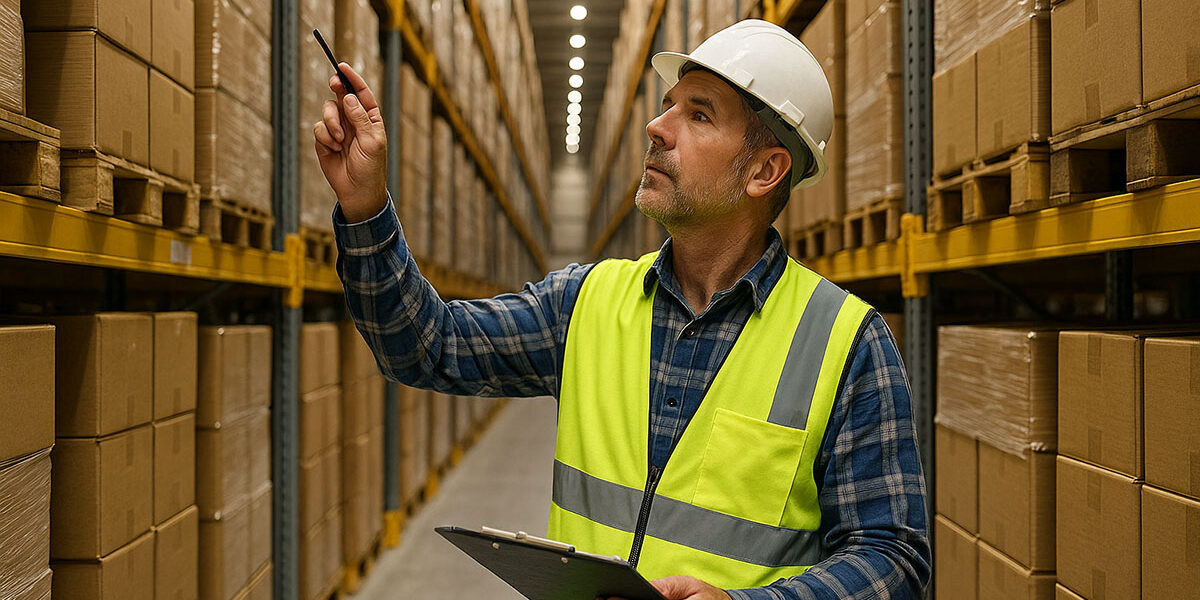Pallet racks are at the heart of any logistics warehouse operation. They support heavy loads, facilitate the movement of products and ensure operational efficiency. But over time, wear and tear, forklift impacts and overloading can weaken these structures. That’s why pallet rack inspection is not just a formality, it’s a major lever for safety and performance.
Why is pallet rack inspection essential?
The key role of pallet racks in modern logistics
Pallet racks allow dozens of pallets to be stored on multiple levels, optimising space and productivity. However, their stability depends directly on their structural condition. An undetected weakness can quickly become a risk of collapse.
The risks associated with uninspected racks
Accidents involving damaged racking are more common than you might think:
- Partial or total collapse of a rack.
- Falling pallets, injury to personnel or even death in the worst cases.
- Production stoppages and financial losses.
Pallet rack inspection allows you to detect anomalies in good time and ensure the integrity of your installations.
________________________________________
What does standard EN 15635 say about rack inspections?
Recommendations for employers
Standard EN 15635 defines European rules relating to the safe use and maintenance of steel storage systems. It requires:
- Periodic visual checks by trained personnel.
- A full annual inspection carried out by an independent expert.
- The preparation of a documented inspection report.
In Belgium, these requirements are reinforced by the Code of Well-being at Work and the RGPT.
Required visual and technical inspections
Every week, internal personnel must check:
- The verticality of the uprights.
- The condition of the beams, base plates and fastenings.
- Any deformations, cracks or corrosion.
The expert carries out a thorough structural inspection once a year.
________________________________________
The steps involved in a professional pallet rack inspection
Step 1: Visual assessment and on-site diagnosis
The inspector carefully examines the key components: uprights, beams, guards, overloads, anchors and accessories. Any damage, even minor, is reported.
Step 2: Classification of anomalies according to a colour code
- Green: minor defect, no immediate action required.
- Orange: planned intervention.
- Red: imminent danger, rack to be unloaded immediately.
Step 3: Detailed technical report and action plan
At the end of the inspection, a comprehensive report is provided:
- List of anomalies detected.
- Photos and severity of defects.
- Maintenance plan and prioritisation of repairs.
Step 4: Repair, monitoring and ongoing compliance
The company repairs the defective components and keeps a maintenance log. This monitoring proves compliance during safety audits.
Step 5: Installation of load indicators
Once the repairs have been carried out, Cornix installs load indicators at the beginning of each row to ensure optimal use of the pallet racks.
________________________________________
Types of pallet racks and their specific inspection requirements
Standard racks: robustness and accessibility
Easy to maintain, they must be inspected regularly at the level of the side members and fastenings.
Dynamic racks: specific points to check
The rollers and rails must be free of deformation and blockages. The inspection of dynamic pallet racks includes testing the proper functioning of the slopes.
Accumulation and drive-in racks
These racks are subject to significant mechanical stress from forklifts. The internal uprights and guide rails must be carefully examined.
Free-standing or mobile racks
Subject to high loads and vibrations, they require a complete structural inspection, particularly of the base plates and movement rails.
________________________________________
Advantages of regular pallet rack inspection
Staff safety and accident prevention
A pallet rack inspection ensures a safe working environment and reduces the risk of injury.
Equipment durability and cost optimisation
Early detection prevents major repairs and extends the service life of the installations.
Why entrust the inspection to a professional expert?
Essential technical skills
An inspector has the necessary training and experience to assess the structural strength of storage facilities.
Cornix’s expertise in rack maintenance and inspection
With over 60 years of experience, Cornix is the partner of choice for:
- Inspections carried out by an expert.
- Preventive and corrective maintenance.
- Detailed technical reports for audits and insurance purposes.
FAQ on pallet rack inspection
- How often should pallet racks be inspected?
A weekly visual inspection and an annual inspection by an expert.
- Who can carry out an inspection in accordance with EN 15635?
Only qualified, independent inspectors can carry out this inspection.
- What are the signs of a damaged rack?
Deformation, corrosion, cracks, bent ladders or twisted side rails.
- Why keep an inspection log?
It proves legal compliance and facilitates safety audits.
- Is pallet rack inspection mandatory?
Yes, according to EN 15635 and the Belgian Code of Well-being at Work.
- What should be done in the event of a red anomaly?
Immediately unload the affected rack and repair it before putting it back into service.
Conclusion: an essential step towards a safe and compliant warehouse
Pallet rack inspection is much more than a regulatory requirement: it is a guarantee of safety, reliability and sustainable performance. Well-maintained, regularly inspected racking that complies with EN 15635 protects your teams, your goods and your productivity. Trust experts like Cornix to ensure the safety of your industrial warehouses.
Find out more about Cornix and its services.







